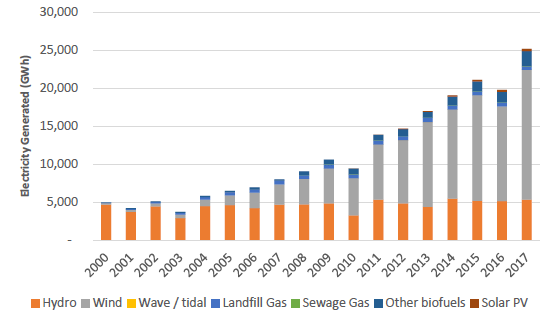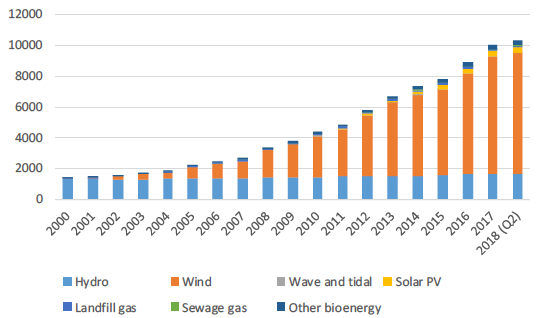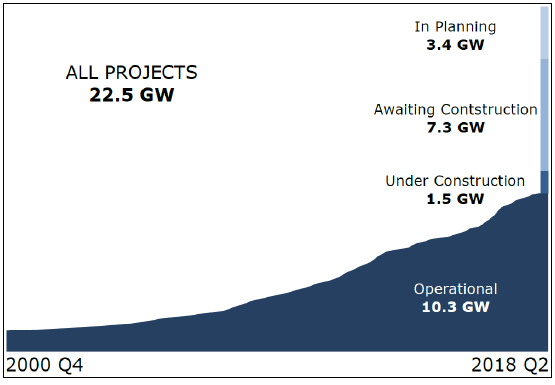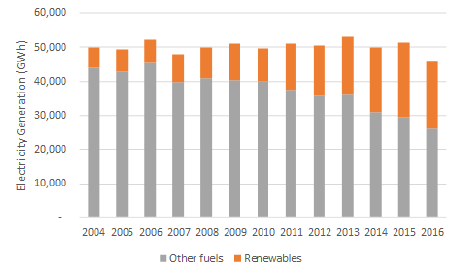Climate Change Plan: monitoring report 2018
The first annual report monitoring progress towards Scotland's Climate Change Plan.
Electricity
Greenhouse gas emissions from the electricity sector decreased by 12.3MtCO2e (83%) between 1990 and 2016. The Climate Change Plan sets out policies and proposals to reduce emissions from this sector by a further 28% between 2018 and 2032, taking the overall reduction in emissions within the sector to 87% when compared with 1990.
The Plan sets out the following two “policy outcomes” for the sector:
1. From 2020 onwards, Scotland’s electricity grid[iv] intensity will be below 50 grams of carbon dioxide per kilowatt hour. The system will be powered by a high penetration of renewables, aided by a range of flexible and responsive technologies.
2. Scotland’s energy supply is secure and flexible, with a system that is robust against fluctuations and interruptions to supply.
Scotland’s energy system continues to evolve and is making the transition from a traditional centralised model, reliant on fossil fuels, to a decentralised model, with a more diverse electricity generation mix incorporating large volumes of renewable electricity.
To support this transition, and to ensure that Scotland’s energy supply remains secure and flexible, the Scottish Government is developing a Networks Vision, to be published later this year. This will take a closer look at the issues, evidence and decisions which will shape Scotland’s future electricity and gas infrastructure. The Scottish Government is also continuing to fund and support innovation as the sector moves towards smarter and more flexible grids, creating new opportunities for households, communities and businesses to shape and benefit from the electricity network.
The latest figures show that, in 2016, Scotland’s generation intensity was 54gCO2e/kWh, falling from 151gCO2e/kWh the previous year, and continuing a downward trend. These continuing reductions, a result of the closure of carbon intensive coal fired power stations, including Longannet which closed in 2016, and a significant increase in renewable electricity generation, put Scotland well on track to meeting this policy outcome in the electricity sector.
Renewable electricity generation capacity in Scotland has more than trebled in the last ten years; as of June 2018, there was 10.3GW of installed renewable electricity generation capacity across the country. Consequently, renewables’ contribution towards the total volume of electricity generated has grown from 18% in 2008 to 43% in 2016. In 2017, it is estimated that renewables generated the equivalent of 69% of Scotland’s electricity demand, up from 54% in 2016 and just over 12% in 2000. The comparable figure for the rest of the UK in 2017 was 24%.
There is also currently an additional 12.2GW of renewables capacity either under construction or at the planning stage, the majority of which is from wind generation, both offshore and onshore. This indicates a strong pipeline, and a substantial level of capacity which could be added to the system in the future.
Output Indicator For Policy Outcome 1:
For the duration of the Plan, Scotland’s electricity grid generation will be below 50gCO2 per kilowatt hour, powered by a high penetration of renewable technologies, including onshore wind, offshore wind, island wind, hydro, solar, marine and bioenergy.
Most Recent Data: Grid generation of 54gCO2e per kilowatt hour in 2016.
Data Source(s):
- Scottish Greenhouse Gas Emissions, 2016 - Climate Change Sectors Paper[1].
- Department for Business, Energy and Industrial Strategy Energy Trends: December 2017, special feature article - Electricity generation and supply figures for Scotland, Wales, Northern Ireland and England, 2013 to 2016[2].
On Track: Yes.
Commentary:
- The carbon intensity of Scottish electricity generation fell from 151gCO2e/kWh in 2015 to 54gCO2e/kWh in 2016. The duration of the Plan is 2018 to 2032, and it is expected that by this start date grid intensity in Scotland will be below 50g/CO2/kWh.
- This fall continues the downward trend from a carbon intensity of 318gCO2e/kWh in 2010, chiefly the result of the closure of Cockenzie and Longannet coal fired power stations in 2013 and 2016, as well as a reduced reliance on gas for power generation. This has significantly reduced the use of fossil fuels for electricity generation, resulting in a large reduction in emissions from power generation in Scotland.
- The reduction in electricity generation from coal and gas fired power stations over the last ten years has been partially offset by an increase in generation from lower carbon sources. This includes nuclear power, but most notably from renewable generation, which increased by more than 150% during this period.
- Although renewable electricity generation slowed in 2016 due to poor weather conditions for wind power, renewable electricity generation statistics for 2017 show a 27% increase on 2016 and a 16% increase on 2015 levels, the previous record year for renewable generation in Scotland.
- The continued growth in renewable generation is expected to be a key driver in reducing the carbon intensity of electricity generation in Scotland.
Output Indicator For Policy Outcome 2:
Scotland’s energy supply is secure and flexible, with a system robust against fluctuations and interruptions to supply.
Most Recent Information: The Scottish Government included System Security and Flexibility as one of the six priorities in the Energy Strategy and, building on that, is publishing a Networks Vision later this year, which will support the development of networks that are able to maintain a supply of energy that is secure, affordable and flexible.
Data Source(s): The Scottish Government’s Energy Strategy[3].
On Track: Too early to make an assessment, a Networks Vision will be published later this year, which will provide more detailed information in relation to this indicator.
Commentary:
- The Scottish Government’s Energy Strategy made clear the vital role that energy supply infrastructure will play in Scotland’s transition to a renewable and low carbon future.
- The Scottish Government is currently developing a Networks Vision, due for publication later this year, which will take a closer look at the issues, evidence and decisions which will shape the future electricity (and gas) infrastructure. It examine the need for networks which are able to maintain secure, affordable and flexible supplies of energy as Scotland shifts to a whole system approach, while operating safely and reliably.
- The Scottish Government will continue to work closely with the key stakeholders in this area, including the UK Government, the Office of Gas and Electricity Markets (Ofgem), network owners and operators, as well as other stakeholders, in order to ensure this outcome.
- The Scottish Government is also continuing to fund and support innovation as the sector moves towards smarter and more flexible grids, creating new opportunities for households, communities and businesses to shape and benefit from the electricity network.
Implementation Indicator For Policy Outcomes 1 And 2:
Increase amount of electricity generated from renewable sources in Scotland.
Most Recent Data: 25,66GWh of electricity generated from renewable sources in 2017.
Annual Change: 5,384GWh increase in electricity generated from renewable sources from 2016 to 2017.
Data Source(s): Department for Business, Energy and Industrial Strategy Energy Trends, Renewables[4].
Commentary:
- Electricity Figure 1 below shows the volume of electricity generated from renewable sources in Scotland, by technology, from 2000 to 2017.
- In 2017 electricity from renewable generation had increased by 27% on 2016 levels, and by 16% on 2015 levels, with 2015 being the previous record for renewable generation in Scotland.
- The continued increasing trend in generation from renewables is largely driven by an increase in installed capacity of wind generation, 2017 in particular saw favourable weather conditions for wind power generation, as compared to 2016.
Electricity Figure 1: Electricity generated (GWh) from renewable sources, Scotland, 2000-2017

Implementation Indicator For Policy Outcomes 1 And 2:
Increase the installed capacity of sites generating electricity from renewable sources in Scotland. By 2030, it is expected that the installed capacity of renewable electricity generation sources will be between 12GW and 17GW.
Most Recent Data: 10.3GW of installed capacity at end June 2018.
Previous Year: 9.6GW of installed capacity at end June 2017.
Change: 0.7GW increase in installed capacity from June 2017 to June 2018.
Data Source(s): Department for Business, Energy and Industrial Strategy Energy Trends, Renewables[4].
Commentary:
- Installed capacity of renewable generation increased from 9.6GW to 10.3GW (8% increase) between quarter 2 of 2017 and 2018, with this increase largely attributed to the increase in operational wind sites.
- Although there is a significant number and capacity of renewable projects in the planning pipeline, it is anticipated that recent and impending changes to subsidy schemes for large and small scale renewables will have an impact on the rate at which additional projects will become operational. The Renewables Obligation closed to all new generating capacity on 31 March 2017, and the UK Government are currently consulting on plans to close the Feed in Tariff on 31 March 2019.
- Despite the closure of these schemes, a limited Contracts for Difference budget (£557 million) remains for supporting certain renewable technologies, including notably offshore wind and Scottish Government continues to work with industry to identify and lobby for new routes to market for onshore wind.
Electricity Figure 2: Installed Capacity of Renewables (MW), Scotland, 2000-2018 Q2

Implementation Indicator For Policy Outcomes 1 And 2:
Increase total community and locally owned renewable energy capacity operational, and in development, in Scotland.
Most Recent Data: 666MW of community and locally owned renewable energy capacity in 2017.
Previous Year: 595MW of community and locally owned renewable energy capacity in 2016.
Change: 71MW increase in community and locally owned renewable energy capacity from 2016 to 2017.
Data Source (S): Energy Saving Trust Community Energy Report[5].
Commentary:
- Community and locally owned renewable energy capacity in Scotland continues to grow. In 2017, the estimated operational capacity was 33% over the original target of 500MW in community and local ownership by 2020. The Scottish Government has now set targets of 1GW of community and locally owned energy by 2020 and 2GW by 2030.
- Electricity Figure 3 shows that in addition to the 666MW of operational capacity under community and local ownership, in 2017 there was an additional 50MW under construction and 283MW consented.
- The largest proportion of community energy was on Scottish farms and estates (40%), followed by local authorities (40%) and community groups (12%). The largest proportional increases have been in the community group and housing association categories, with capacities increasing by 21% and 25% respectively.
- Despite challenges facing local and community owned projects, including the proposed closure of the Feed in Tariff, the Scottish Government remains committed to supporting these projects, recognising not only the economic and clean energy benefits they bring, but also the community and social benefits.
Electricity Figure 3: Community and locally owned renewable energy capacity in different stages of development (MW), Scotland, June 2017

Implementation Indicator For Policy Outcomes 1 And 2:
Increase total renewable capacity in Scotland by planning stage.
Most Recent Information: As of June 2018 Scotland had 12.2GW of renewable capacity either under construction or at the planning stage.
Information Source(S):
- Department for Business, Energy and Industrial Strategy Energy Trends, June 2018[6].
- Department for Business, Energy and Industrial Strategy Renewable Energy Planning Database, April 2018[7].
Commentary:
- The total renewable capacity of 12.2GW currently under construction or in planning in Scotland is greater than the 10.3GW capacity currently deployed.
- As of June 2018, wind projects account for 90% of the capacity in the pipeline. Offshore wind projects account for 5% of the total projects in the planning system and make up around 43% of total installed capacity, while onshore wind makes up 62% of the projects and 48% of the installed capacity.
- Despite a high number and capacity of projects in the pipeline, the Scottish Government recognises that there are a number of factors which mean that not all projects in planning will progress to commissioning, and that grid intensity and renewable electricity ambitions remain challenging.
Electricity Figure 4: Renewable Capacity in Scotland by Planning Stage, July 2018

Implementation Indicator For Policy Outcomes 1 And 2:
Increase the share of electricity generated from renewable sources, as a proportion of total electricity generated in Scotland.
Most Recent Data: 42.9% of all electricity generated in Scotland came from renewable sources in 2016.
Previous Year: 42.4% of electricity generated from renewable sources in 2015.
Change: 0.5 percentage points increase in the proportion of electricity generated from renewable sources between 2015 to 2016.
Data Source(s): Department for Business, Energy and Industrial Strategy Energy Trends, December 2017[8].
Commentary:
- Renewable electricity generation in 2016 was down 10% on 2015 levels, due to poor weather conditions for wind power. Despite this, the proportion of total electricity generated from renewables increased, due to a sharp decrease in coal production following the closure of Longannet in March 2016.
- The proportion of electricity generated by renewables in Scotland has steadily increased over time, growing from 12% in 2004 to 43% in 2016. Even with a substantial reduction in renewable generation in 2016, the proportion of electricity generated by renewables increased by around 0.5 percentage points from the previous year.
- Statistics for the proportion of all electricity generated in Scotland in 2017 will not be released until December 2018. Given that renewables capacity and generation has greatly increased in 2017 from 2016, and that generation from fossil fuels will have reduced, it is expected that the total proportion of electricity generated from renewables will continue to increase in 2017.
Electricity Figure 5: Share of Electricity Generated (GWh) by Renewables, 2004 - 2016

Contact
Email: Decarbonisation Division
There is a problem
Thanks for your feedback